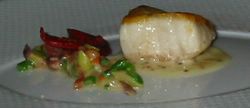White Truffle Oil: A Small Bit of Luxury
Thankfully, there are ways to enjoy the wonderful, earthy and delicate taste of the white truffle year-round without completely emptying your bank account. One of these is through the use of white truffle oil. The name "white truffle oil" is actually a bit of a misnomer; the oil does not literally come from white truffles, but is instead olive oil that has been infused with their flavor. There are numerous brands of white truffle oil available on the market, with significant variation among them in taste, intensity and price. My favorite, by far, is the one sold by Urbani Truffles USA Ltd. in Pennsylvania. Urbani is a family-owned business that is actually the largest United States importer and distributor of fresh truffles, so it's no surprise that they also offer some of the best truffle products around. Urbani's white truffle oil has a high-quality olive oil base, with an intoxicating fragrance and intense flavor.
White truffle oil is not cheap. Urbani's version typically sells for around $40 for an 8 oz. bottle, and I have seen other inferior brands in gourmet stores selling for even more. One mitigating factor here, however, is that the oil is typically used only for flavoring; it is rarely, if ever, used for cooking, as the flavor is so delicate that it will be destroyed if the oil is exposed to direct heat for prolonged periods of time. Furthermore, white truffle oil is so intense, that a very small amount goes a very long way. Accordingly, an 8 oz. bottle of the oil will typically last several times as long as the 8 oz. bottle of olive oil sitting beside it on the pantry shelf.
The possibilities for using white truffle oil are virtually endless, although it seems to work especially well in combination with relatively mild flavors that are not overly assertive. Swirl some into finished soups such as potato leek or cream of mushroom. Try making it the star ingredient in a savory custard, or pairing it with a delicate flavor like cauliflower in a savory panna cotta. Toss some gnocchi with white truffle oil and kosher salt, or drizzle some oil on top of ravioli stuffed with butternut squash. Blend it into your favorite risotto recipe right before serving, or add to scrambled eggs, hollandaise sauce, or other egg-based dishes once they are complete.
Here’s a favorite of mine – sauté some shallots and fresh summer corn in a bit of olive oil, salt to taste, and then mix in some white truffle oil right before eating. Even a decidedly non-gourmet dish like macaroni and cheese takes on an entirely new dimension when some white truffle oil is stirred in at the last minute.
I encourage you to experiment with white truffle oil and see what you can come up with. Just be sure to add the oil to your dish after it has been completed and removed from the heat; never put it into a pan on the stovetop unless the cooking process is moments away from being finished, otherwise the oil will quickly lose its white truffle flavor. (Note that the flavor seems to hold up fine when the oil is baked, for instance, in a custard, but I would still be wary of high oven temperatures.) So, good luck, and please do let me know if you discover some particularly satisfying ways to use this great product!























